Response of Thin Reinforced Concrete Slab under Elevated Temperature against Large Mass Impactor
| ✅ Paper Type: Free Essay | ✅ Subject: Engineering |
| ✅ Wordcount: 3359 words | ✅ Published: 23 Sep 2019 |
Response of Thin Reinforced Concrete Slab under Elevated Temperature against Large Mass Impactor
ABSTRACT
The response of reinforced concrete slab against large mass impact is being attention for the industry as well as commercial applications for a long time. It was observed that many industrial problems require the vulnerability assessment since large mass of hard objects traveling with low velocities on relatively thin concrete slabs. Therefore, this manuscript focuses on the penetration and perforation of thin concrete plates impacted normally by cylindrical impactor with flat nose. The numerical investigations have been carried out on thin reinforced concrete plates using ABAQUS/Explicit finite element program. The thickness of reinforced concrete plate was varied as 20 and 40 mm and the mass of impactor was 4 and 32 kg and impacted by 8.14 m/s velocity. The reinforcement of 6 mm diameter of single layer placed 90 mm spacing at both the directions. The span of the target is 400 mm and their boundaries were clamped tightly. The inelastic behavior of concrete and steel reinforcement bar has been incorporated through Johnson–Holmquist damage (JH2) model and Johnson-cook (JC) models available in ABAQUS, respectively were considered in the present study. The temperatures of target was varied as 293, 500, 900 and 1300 K. The results were predicted and discussed in terms of reaction force, residual velocity, damage intensity and von-Mises stresses on target. The study thus presents a detailed numerical investigations of the material behavior under large masses and leads to some important conclusions pertaining to the mechanics during the interaction of penetrator and target.
KEYWORDS: Thin reinforced concrete slab, Deformation and Damages, Impactor mass, Elevated temperature.
INTRODUCTION
Thin reinforced concrete slabs are being currently used widely in the field of civil engineering such as covering material for industrial flooring, rehabilitation of surfaces of bridge decks, temporary structures etc. The response of such plates against drop impact is being attention for the industry as well as commercial applications for a long time. A considerable amount of studies has been conducted to understand the penetration behaviour of steel plates against low-velocity projectiles impact () however few studies have been focused on the local behaviour of thin plates against large masses passing at low velocity. Clifton and Knab (1983) examined the relationship between the compressive strength and the impact resistance of concrete, and it was found that the impact resistance increased with the compressive strength. Hanchak et al. 1992 observed that compressive strength of concrete is not directly associated with the impact resistance of concrete slab. Dancygier and Yankelevsky (1996) found that a reduced brittleness when steel fibers were added into high strength concrete mixes. Borvik et al. (2002) concluded that the ballistic limit velocity increases to a maximum of 20% if the compressive strength of the concrete increases. Tai (2009) found that addition of steel fibers increases the split tensile strength, flexural strength and reduces brittleness of concrete. It was concluded that addition of 2% and 5% by volume of steel fibers resulting split tensile strengths of 21.9 and 31.6 MPa respectively, and almost equal to the compressive strength of normal concrete, improves the impact resistance significantly. Li et al. (2016) found that ultra-high performance concrete displays an improved resistance compared to conventional concrete. Othman and Marzouk (2016) concluded that the distribution of the steel reinforcement majorly affects the crack pattern and deformation mode. Rajput and Iqbal (2017) was found that the reinforcement minimizes the scabbing and spalling of concrete. Explicitly, experimental investigations are important, however there is always an important need for the implementation of numerical solutions. Few numerical models have been implemented on the impact behavior of reinforced concrete structures (Ranjan et al (2014), Guo et al. (2017), Oucif and Mauludin (2018), Senthil et al. (2018)).
Based on the detailed literature survey, it is observed that the response of the thin reinforced concrete against large masses has been rarely studied. Response of the concrete slab under elevated temperatures also rarely been studied heretofore. Therefore, present manuscript focuses on the impact resistance of thin reinforced concrete targets of 20 and 40 mm against 4 and 32 kg mass cylindrical flat nose impactor speed of 8.14 ms-1 (assumes drop height of 3.15 m) through numerical simulation using ABAQUS/CAE finite element program. The inelastic behavior of concrete and steel reinforcement bar has been incorporated through JH2 and JC models available in ABAQUS, respectively were used in the present study. The temperatures of target was varied as 293, 500, 900 and 1300 K. The results were predicted and discussed in terms of reaction force, residual velocity, damage intensity and von-Mises stresses on target.
CONSTITUTIVE MODELLING
The behaviour of steel reinforcement and concrete was predicted using the already defined models in ABAQUS finite element program. For reinforcing steel, damage behaviour has been predicted using J-C model (Johnson-cook model). The parameters for J-C model was used for this study were taken from the literature, see Iqbal et al 2015. Inelastic non-linear mechanical behaviour of concrete was defined in the model using JH-2 ceramic model, it provides a general capability for simulating the behaviour of concrete and other quasi-brittle materials such as strain rate effects, dependence on pressure-strength (Holmquist et al, 1993). According to JH-2 model, with increase in plastic deformation, the damage variable also increases. Strength is based on the von Mises yield stress given by
where
,
are the normalized intact equivalent stress and normalized fractured equivalent stress respectively. D is the damage variables whose value lies in between 0 (undamaged) & 1 (total damage). The material parameters for JH-2 model is shown in Table 1, which are proposed byHolmquist et al, 1993. The pressure Volume relationship for brittle materials is given by K1+K2K3 if ≥ 0 (Compression) and K1if tension). K1, K2, K3are the material Parameters and deals with the density of the material.
Table 1 Material parameters of the concrete material, Holmquist et al, 1993.
|
(kg/m3) |
G (GPa) |
A |
n |
B |
m |
C |
|
|
14.86 |
0.79 |
0 |
1.6 |
0.61 |
0.007 |
|
|
T (GPa) |
Smax |
Sfmax |
HEL (MPa) |
PHEL(MPa) |
|
|
1.0 |
0.00354 |
7 |
0 |
80 |
48 |
1 |
|
D1 |
D2 |
|
|
K1(GPa) |
K2 (GPa) |
K3(GPa) |
|
0.04 |
1 |
0.01 |
1.0 |
85 |
-171 |
208 |
(c)
NUMERICAL MODELLING
The numerical investigation was carried out to determine the behaviour of concrete plate subjected to the normal impact of low-velocity projectile (Impactor) using ABAQUS/CAE. Two targets of varying thickness were modelled i.e. 40 and 20 mm Concrete plate with reinforcement of 6 mm diameter. The behaviour of mild steel reinforcement was simulated using the Johnson-Cook Model whereas, the non-linear behaviour of concrete was modelled using Johnson-Holmquist (JH-2) model readily available in finite element code, ABAQUS/CAE. Projectiles(impactors) were impacted on 40 and 20 mm thick target plates of 400 mm diameter including cover cocnrete at bottom as well as peripheral of target. Impactors were modelled as a three dimensional analytical rigid shell element whereas the concrete plate was modelled as three dimensional deformable body and reinforcements as three dimensional beam element (B31). Both ways reinforcements (longitudinal and transverse) were placed at a distance of 90 mm c/c with a clear cover of 10 mm such that it forms a grid see Fig 1(a). The type of constraints used for bonding between steel and concrete is “Embedded region” readily available in ABAQUS. The reinforcement was considered as an embedded region while concrete was considered to be host region. The mass of impactor was considered 4 Kg and 32 Kg. The velocity of the impactor(s) is considered to be 8.13 ms-1 (considering a drop height of 3.36 m with gravitational force). The position of the reinforcement and layout was shown in Fig. 1(b). The diameter of impactors (d) was 12 mm, see Fig. 2(a) and the finite element model of impactor is shown in Fig. 2(b). Surface-to-surface (explicit) interaction was used and kinematic contact algorithm was employed for making contact between impactor, concrete target & reinforcement. The coefficient of friction between these bodies is assumed to be zero due to the low velocity of impactor. In all the simulations, the projectile was considered as master surface and target and reinforcement as node-based slave surface. To maintain the fixity at the perimeter of the circular plate “ENCASTRE” option was used, see Fig 2(c). The meshing of the target plate was considered as eight noded linear hexahedron element (C3D8R) of 10 mm at the centre of the plate (primary area). Tertary area was meshed with the same type of elements (C3D8R) however the size of element was varied from 20 mm to 30 mm. A six noded tetrahedral element (C3D4) was introduced between primary and secondary area for generating compatibility and reducing the computational time. The hourglass control was kept as default for all the elements and the velocity was incorporated using load module available in ABAQUS.




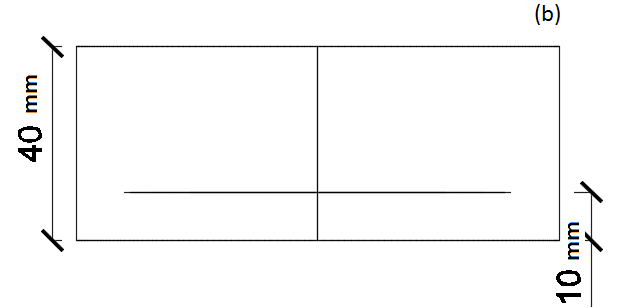
(a)
Fig 1. Typical (a) schematic of concrete plate with reinforcement grid and (b) position of reinforcement bar


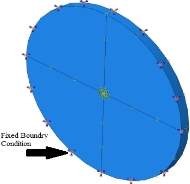
(b)
(c)
(a)
(a)
Fig 2. Typical (a) schematic and (b) finite element model of projectile and (c) 20mm thick target with fixed boundary conditions.
The simulations were carried out on circular thin slab against large mass falling impact loading under elevated temperature. The JH2 model has been employed for predicting the material behavior of the concrete, whereas the Johnson-Cook model was also employed for predicting the behavior of steel reinforcement bar. The simulated results thus obtained have been compared with the conventional method. A detailed mesh convergence has been carried out to study the influence of mesh size in the impact region of target. The size of element was varied as 0.005 × 0.005 × 0.005 m, 0.01 × 0.01 × 0.01 m, 0.015 × 0.015 × 0.015 m and 0.020 × 0.020 × 0.020 m. Deformed profile (Mises stresses in concrete and steel bar) for the 40 mm thick target against 32 kg mass at 293 K temperature having varying mesh size is shown in Fig. 3 (a)-(b). The von-Mises stresses in concrete for 5, 10, 15 and 20 mm mesh size was …, ….., ….. and ……. MPa for chosen case is shown in Fig. 3(a). The percentage variation of stresses between …………………. Hence, 10 mm mesh size was considered for conducting further simulations. In case of Mises stresses in reinforcement with mesh sizes of 5, 10, 15 and 20 mm was …….., ………, ….. and …. MPa, see Fig. 3(b). The percentage variation of stresses between …………………………………………….. ……. ……………. Therefore, 10mm mesh size was considered as reference and used further for conducting simulations and predicted the response of target under elevated temperature.
(i-a)
(ii-a)
(iv-a)
(iii-a)
(iii-b)
(i-b)
(iv-b)
(ii-b)
Fig. 3 Von-Mises stresses (MPa) on (a) concrete and (b) steel reinforcement bar at (i) 5 (ii) 10 (iii) 15 and (iv) 20 mm mesh sizes
RESULT AND DISCUSSIONS
The simulations were carried out on 20 and 40 mm thick thin slab against large mass falling impact loading under elevated temperature. The JH2 model has been employed for predicting the material behavior of the concrete, whereas the Johnson-Cook model has been used for predicting the material behavior of steel reinforcement. The simulations were carried out to understand the influence of varying mass of impactor and varying temperature. The striking velocity of impactors is chosen as 8.14 m/s and the impact response studied against this velocity. Also, the response of target at elevated temperature has been studied and the temperature was varied from ambient temperature and 500, 900 and 1300K. The response of structural elements were observed in terms of stresses, damages and reaction forces, therein was presented and discussed in this section.
The impact resistance of 20mm and 40 mm thick reinforced concrete targets have been studied through cylindrical flat nose object having masses of 4 and 32 kilograms by finite element simulations and the predicted reaction forces were shown in Figs. 4 and 5. The force offered by the 20 mm thickness target at ambient temperature is 72.14 KN whereas for 500, 900, 1300 K it is 64, 61.21, 48.19 KN respectively, see Fig. 4. Similarly, reaction forces offered by the target of 40 mm thickness against 32 kg impactor is 67.19, 65.53, 65.27, 64.16 KN at 293, 500, 900, 1300 K temperature respectively, see Fig 5. For both the thickness it is seen that the reaction force offered by the targets are inversely proportional to the temperature i.e. with an increase in temperature, impact strength decreases. At elevated temperature, concrete loses its compressive strength hence the ability of concrete to resist the loads decreases significantly. None of the targets is able offer the resistance due to the large mass of the impactor i.e. 32 kg and. A complete perforation in both the targets at all the temperatures is clearly seen from Figs. 4 and 5.
(i-a)
(i-b)
(i-d)
(i-c)
(ii-a)
(ii-b)
(iii-d)
(ii-c)
Fig 4. Forces offered by (i) 40 and (ii) 20 mm thick targets against 4 kg mass impactor at a) 293 b) 500 c) 900 d) 1300 K temperature
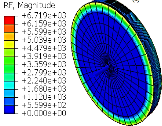

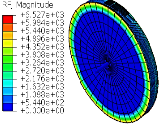
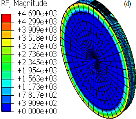
(i-b)
(i-a)
(i-c)
(i-d)
(ii-a)
(ii-b)
(ii-c)
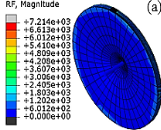
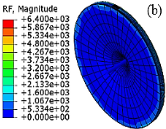

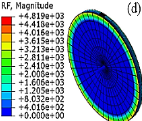
(ii-d)
Fig 5. Forces offered by (i) 40 and (ii) 20 mm thick targets against 32 kg mass impactor at a) 293 b) 500 c) 900 d) 1300 K temperature
The response of thin reinforced concrete slabs against large masses travelling with low incidence velocities is studied in terms of residual velocity, see Figs. 6 and 7. It is seen that the heavier mass projectile (32 kg) perforated both the targets i.) 40mm ii) 20 mm at ambient as well as increased temperatures. However, at lower temperature, the resistance of target is high hence residual velocity varies between 3.26 – 4.40 ms-1 and 2.74 – 6.86 ms-1 respectively. The 4 kg projectile is not able to perforate any of the studied targets hence residual velocity is insignificant for this case. The perforation process and residual velocity can be seen in Fig 6. Numerically obtained residual velocities of impactor were shown in Table 2. The maximum residual velocity is found in case of 20mm thick RC target at 1300K. This is due to the fact that the reinforcement present inside the concrete is broken down as reinforcement is also not able to accommodate the energy transferred by the impactor at high temperature, as a result, no obstruction is left for impactor to slow down. see Fig 7.
Table 2 Numerically obtained residual velocity of 32 kg impactor.
|
Temperature |
Thickness of target |
293 |
500 |
900 |
1300 |
|
Residual Velocity (ms-1) |
20mm |
2.74 |
2.94 |
3.86 |
6.86 |
|
40mm |
2.75 |
3.52 |
4.08 |
4.40 |
(i-a)
(i-b)
(i-d)
(i-c)
(ii-a)
(ii-b)
(iii-d)
(ii-c)
Fig 6. Residual Velocity of 4 kg impactor against (i) 40 and (ii) 20mm targets at ambient temperature on (a) 1.5 (b) 3.0 (c) 4.5 (d) 6.0 (e) 7.5 and (f) 9.0 milli seconds.

(i-f)
(i-a)
(i-e)
(i-d)
(i-c)
(i-b)

(ii-d)
(ii-c)
(ii-a)
(ii-e)
(ii-b)
(ii-f)
Fig 7. Residual Velocity (m/s) of 32 kg impactor against (i) 40 and (ii) 20mm targets at ambient temperature on a) 1.5 b) 3.0 c) 4.5 d) 6.0 e) 7.5 f) 9.0 milli seconds.
The response of thin slabs against large masses travelling with low incidence velocities was studied in terms of damage intensity, see Figs. 8 and 9. As discussed earlier, residual velocity is insignificant in case of 4 kg impactor hence global deformation caused by 4 kg impactor at varying temperature were studied. It was observed that as the temperature rises the intensity of deformation also increases and was noticed maximum in case of 1300 K temperature. The deformation varies in the range of 8.9 – 9.8 mm. This can be explained as, at elevated temperatures the reinforcement might behave more ductile which results into more displacements. The depth of penetration also comes out to be the same for most of the targets against 4 kg impactor and varies in the range of 4 – 6 mm. During perforation, damage contours are plotted and it is seen that when impactor touch the reinforcement, see Fig 8, damage start spreading to the outer part of the target i.e. from primary area of the impact, local damage spread to the whole body hence eliminating the risk of extensive scabbing. Reinforcement helps in distributing the stresses to the whole body of target. The same phenomenon is followed in other simulations.
(a)
(b)
(d)
(c)
Fig 8. Damage intensity of 20 mm target at (a) 1 (b) 2.5 (c) 5.2 (d) 9 milliseconds against 32 kg mass at 500 K temperature


(b)
(a)
(c)
(d)
Fig 9. Damage intensity of 40 mm target at a) 1 b) 2.5 c) 5.2 d) 9 milliseconds against 32 kg mass at 500 K temperature
The response of thin slabs against large masses travelling with low incidence velocities was studied in terms of von-Mises stresses in concrete, see Figs. 10 and 11. ………………………… ………………………….. ……………… ……………. …………. ………………………. ……………………….. ………………………… ……………….. ………….. ………………………………………………………………………………………………………………… …………………………………………………………………………………………….. ………..
(a)
(b)
(d)
(c)
Fig 10. Von-Mises stresses (MPa) of concrete against 4 kg impactor at a) 293 b) 500 c) 900 d) 1300 K temperature.
(a)
(b)
(d)
(c)
Fig 11. Von-Mises stresses (MPa) of concrete against 32 kg impactor at a) 293 b) 500 c) 900 d) 1300 K temperature.
CONCLUSION
The present study addresses the finite element investigation on the behavior of thin reinforced concrete slab under elevated temperature against large masses. The impact strength of reinforced concrete target of varying thickness was studied against flat impactor of various masses. The striking velocity of impactors was chosen as 8.14 m/s and the mass of impactor were 4 and 32 kg. Also, the response of target at elevated temperature has been studied and the temperature was varied as 293, 500, 900 and1300K. The results thus obtained in terms of reaction forces, residual velocity, damage intensity and von-Mises stresses were compared and the following conclusions were drawn.
- It is concluded that the higher mass impactor completely perforated the target and at higher temperature i.e. 1300 K, breaks the reinforcement as well. At lower temperature, the resistance of target is high hence residual velocity varies between 3.26 – 4.40 ms-1 and 2.74 – 6.86 ms-1 for 40 mm and 20 mm targets respectively.
- The resistance of both the target decreases with increase in temperature due to loss of compressive strength of the target at higher temperature. For 4 kg impactor depth of penetration is taken into consideration and seen that with increase in temperature the depth of penetration also increases.
- Damage contours are plotted for 32 kg impactor, which shows the distribution of stresses and damage to the outer or secondary part of the target at 500 K. With such type of behaviour it is concluded that, reinforcement helps in distributing the stresses to the whole body of target and prevent the excessive scabbing at the rear side of the target material.
REFERENCES
- ABAQUS, (2014) 6.14 Documentation. Dassault Systemes Simulia Corporation.
- Borvik, T., Langseth, M., Hopperstad, O. S., & Polanco-Loria, M. (2002). Ballistic perforation resistance of high performance concrete slabs with different unconfined compressive strengths. WIT Transactions on The Built Environment, 59.
- Clifton J.R., Knab L.I., Impact test of concrete, Cem. Concr. Res. 13 (4) (1983) 541–548.
- Dancygier A.N., Yankelevsky D.Z., High strength concrete response to hard projectile impact, Int. J. Impact Eng. 18 (6) (1996) 583–599.
- Hanchak, S. J., Forrestal, M. J., Young, E. R., & Ehrgott, J. Q. (1992). Perforation of concrete slabs with 48 MPa (7 ksi) and 140 MPa (20 ksi) unconfined compressive strengths. International Journal of Impact Engineering, 12(12), 1–7.
- Holmquist, T.J, G.R Johnson, and W.H Cook. 1993. “A Computational Constitutive Model for Concrete Subjected to Large Strains, High Strain Rates, and High Pressures.” In 14th International Symposium, Vol 2; Warhead Mechanisms, Terminal Ballistics, Qubec, Canada: ADPA, 591–600.
- Guo, Y. B., G. F. Gao, L. Jing, and V. P.W. Shim. 2017. “Response of High-Strength Concrete to Dynamic Compressive Loading.” International Journal of Impact Engineering 108: 114–35.
- Iqbal, M.A., Senthil, K., Bhargava, P. and Gupta, N.K., (2015), “The characterization and ballistic evaluation of mild steel”, Int. J. Impact Eng., 78, 98-113.
- Johnson, G.R. and Cook, W.H. (1985), “Fracture characteristics of three metals subjected to various strains, strain rates, temperatures, and pressures”, Eng. Fracture Mech., 21, 31–48.
- Li, J., Wu, C., Hao, H., Wang, Z., & Su, Y. (2016). Experimental investigation of ultra-high performance concrete slabs under contact explosions. International Journal of Impact Engineering, 93, 62–75.
- Othman, H., & Marzouk, H. (2016). An experimental investigation on the effect of steel reinforcement on impact response of reinforced concrete plates. International Journal of Impact Engineering, 88, 12–21.
- Oucif, C and Mauludin L.M.. (2018). “Numerical Modeling of High Velocity Impact Applied to Reinforced Concrete Panel.” Underground Space (2): 591–600.
- Rajput, A., & Iqbal, M. A. (2017). Ballistic performance of plain, reinforced and prestressed concrete slabs under normal impact by an ogival-nosed projectile. International Journal of Impact Engineering, 110, 57–71.
- Ranjan, R, Banerjee S, Singh R. K., and Banerji P. (2014). “Local Impact Effects on Concrete Target Due to Missile: An Empirical and Numerical Approach.” Annals of Nuclear Energy 68: 262–75.
- Senthil, K., Rupali, S. and Kaur, N. (2018). “The performance of monolithic reinforced concrete structure includes slab, beam and column against blast load”, J. Mat. Eng. Struct. 5(2), 137-151.
- Tai, Y. S. 2009. “Flat Ended Projectile Penetrating Ultra-High Strength Concrete Plate Target.” Theoretical and Applied Fracture Mechanics 51(2): 117–28.
Cite This Work
To export a reference to this article please select a referencing stye below:
Related Services
View allDMCA / Removal Request
If you are the original writer of this essay and no longer wish to have your work published on UKEssays.com then please click the following link to email our support team:
Request essay removal


